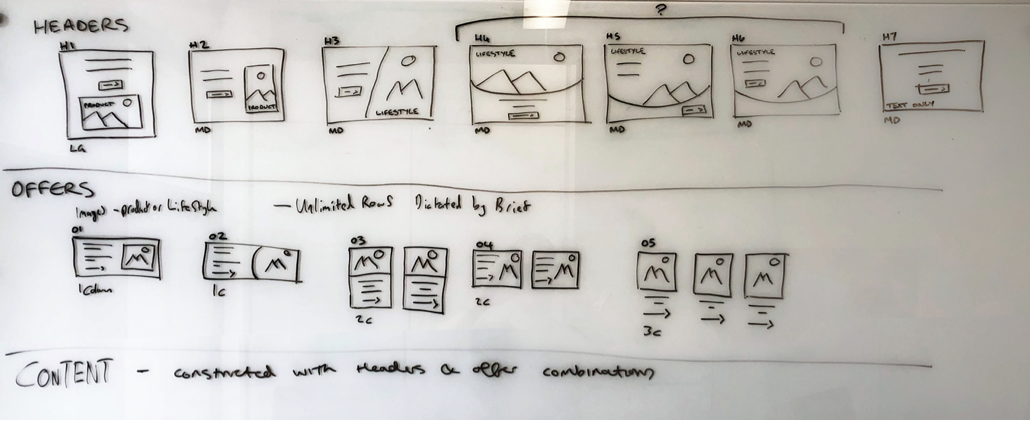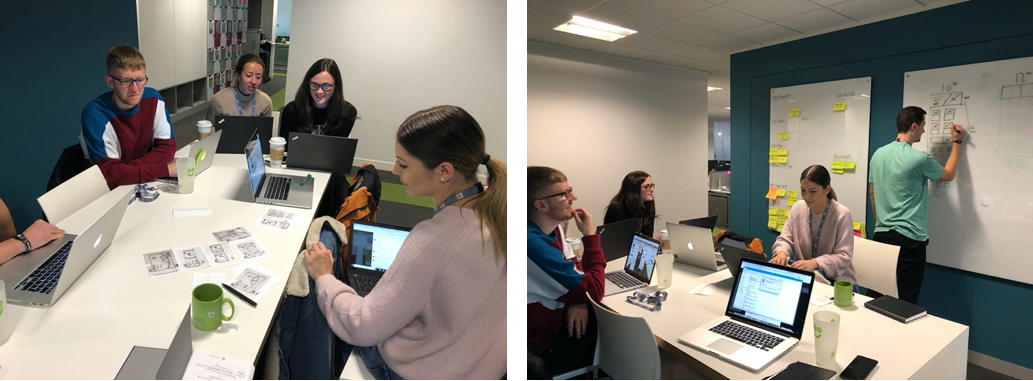The AO CRM Revolution
How might we reduce the email production process across all teams to allow more time for storytelling and the evolution of the CRM channel?
CRM is the one of the biggest channels that AO.com uses to connect with its customers, with around 1.4 Million emails being sent every week. This is why it is imperative that the creation of these emails is as efficient as possible, and each one tells a story that drives customers to engage.
The Why
The initial brief was to design a set of email templates for predefined sends, however with a little bit of discovery it was clear this would be a temporary solution and only last a few months and end up in the same situation further down the line.
At the time the emails were inconsistent from a design and storytelling point of view. Multiple messages were competing for attention and there was no set hierarchy. Colours appeared to be added arbitrarily giving a rainbow banding effect. All the text elements were placed within images so none of the text was live and couldn’t be read by email clients – as we discovered in this process if an email has more than 50% image content vs live text it has a higher chance of being directed to spam.
The reason for most of these issues seemed to stem from the process, it was taking 2 designer and 2 copy writers 2 weeks to produce 2 emails. Apart from the numeric iteration, there is nothing positive in that sentence. Part of the issues were regular last minute changes from various stakeholders across the business, usually down to trading changes. Changes were often still being made on the day of send which meant the developers had their time reduced. This issue seemed to stem from creating the emails two weeks in advance, inevitably things are going to change in that time in such a fast paced environment as AO.com.
The other element that seemed to be holding the design back was a lack of definition in templates and using the wrong tools for the job. Each email would be crafted in Photoshop and could be upward of 2gb, which would put a strain on the designers Mac and almost break the developers PCs.
Something needed to change.
The How – Design Thinking
While starting to look at the template designs I took influence from Brad Frost and his Atomic Design principles. The idea behind atomic is that you design a collection of components that join together to give you elements that then build emails. These assets can be arranged in infinite of combinations creating unique emails every time rather than a finite number of locked templates. As Stephen Hay says in the foreword of Brads book "We’re not designing pages, we’re designing systems of components" It allows the shift from template creation, which arguably the customer wouldn’t notice, to focus on compelling storytelling.
With this idea in mind I began to craft a number of elements that each email could be composed of. I started by looking at the data from previous sends, finding out which elements we had used previously performed well and ones that did not, which emails had more click through and which had the best revenue return. Taking the elements that seemed to be engaging most I used these as a basis to start crafting new atoms/organisms.
Along with my team we sketched out on a whiteboard a collection of tier one and tier two organisms that we could see being used in the email creation. It was all very quick and collaborative, the sketches were rough but gave us a greater understanding of what it was that we wanted to achieve.
I decided that the best way to get these sketches into something that the team could use was to have an innovation in tools. It was time to move away from Photoshop – software that has been at the heart of many designers toolkits since its creation in 1988 – to the relatively young Adobe XD. Photoshop is brilliant at what it does but, it is photo editing software not digital design software, it creates brilliantly complex files at the expense of huge files sizes that put a strain on the machines. Adobe XD on the other hand is built for digital application, it creates files that are around 1% the size of the Photoshop files we were creating. It enables designers to create pixel perfect designs and output all the assets for development to save time.
The main benefit of Adobe XD are the ability to have a master document with all the template assets in that can be linked to each email so any designer can pull in signed off elements quickly. The other is the ability to collate feedback on XDs comment functionality, by creating unique URLS for each email which have the ability for stakeholders to pin amendments on the design all in one place.
Given that part of the problem was being caused by the process it made sense that this was addressed too, hence the adoption of Dual Track Agile workflow and the 80/20 principle. Splitting the workflow into a discovery track that hypothesises, prototypes and validates with 80% of effort spend on this track outputting only 20% of the volume which feed the delivery track. The delivery track delivers a working product based on validated experiments from the discovery track with 20% of effort outputting 80% of the volume of the CRM stream. Both tracks feed each other creating a backlog of requirements, new ideas and improvements.
The How – implementation
Who works on the emails has changed with dedicated designers and copywriters who focus on the CRM stream, and how the emails are worked on. Co-creation is implemented to craft each of the emails to guarantee the correct story is being told and the marketing hierarchy is implemented. CRM team, copy and design now sit together for scheduled times across two days, to work through the brief, copy and design together. This has created a cross-disciplinary team that have shared goals and KPI’s, we are all in it together and work closer to get the best possible solution. Arranging dedicated sign off and amendment times with key stakeholders to reduce the amount of time spent on changes.
Why does this agile way or working work?
It pushes cross-dept collaboration over siloed working which enables the team to gain a better understanding of the brief, which leads to greater creative consistency. Valuing individuals and interactions over processes and tools mean the team get to spend time to craft a story and give the emails flow that leads to better engagement.
The face to face nature of the new process gives the teams chance to share knowledge, ideas and skills making sure every part of the email is working as hard as it can. This combined with instant feedback on how the emails are performing means optimisation from week to week and get instant results from any tests run. We now able to respond to change quickly over following a strict predefined plan.
The Results
The process has been refined to work to a three-day schedule instead of the two week turn around previously. It starts having a brief signed off by all stakeholders on day one so everyone knows the theme and any trade inclusions ahead of creation, in turn reducing post-design amendments. Day two is the collaboration session in which the cross disciplinary team crafts the email. Day three collated feedback is actioned and the email goes into development.
The changes to process and the redesign of the email elements have resulted in increased design consistency and improved build accuracy. They contain a clear flow with hierarchy, honed themes and colour stories that create a more engaging email. Word counts and CTA rules give visual balance to copy and add direction, personality and urgency.
From the first week working in the new process stakeholder feedback was overwhelmingly positive. However none of that really matters if it doesn’t have an impact with the customer. The benchmark of 6% for good CTO had been set with previous emails getting around 3.8%. The first few weeks had an average of 7% showing that crafting the story was working, but we hit our peak during Black Friday at 25% CTO which is phenomenal.
As feedback is collated it appears what was set as the challenge has been achieved, but continuous analytics will assist in making iterative improvements as the project goes on.
The Conclusion
Using a combination of atomic design, agile working and diving deeper into the problems beyond the initial brief we have managed to disrupt the email creative process and build a new way of working that is delivering immediate results.
There are three standout factors that make this work, the holy trinity of email design.
Working as an Agile CRM team of designers, copy writers and CRM managers face-to-face for the two days of production. This has strengthened working relationships and given the team a shared goal.
Gaining instant feedback from both, stakeholders at dedicated times in the creation process to get rid of any sign off bottlenecks, and from analytics from the previous weeks emails to greater understand what worked and what didn’t.
Engaging the customer with compelling storytelling, with clear hierarchy through colour themes and purposefully designed elements that create an email that encourages engagement.
These three are the foundations of the new CRM design process, and these are the reasons why the process is working.
We have made great progress so far, however we aim to continue this trajectory and plan to become a world leading CRM design team.







